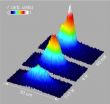(Press-News.org) Sensors that work flawlessly in laboratory settings may stumble when it comes to performing in real-world conditions, according to researchers at the Department of Energy's Oak Ridge National Laboratory.
These shortcomings are important as they relate to safeguarding the nation's food and water supplies, said Ali Passian, lead author of a Perspective paper published in ACS Nano. In their paper, titled "Critical Issues in Sensor Science to Aid Food and Water Safety," the researchers observe that while sensors are becoming increasingly sophisticated, little or no field testing has been reported.
"Although sensor researchers are keenly aware of the various issues challenging their particular technologies, outsiders may perceive an overestimated level of performance, or in certain cases, the availability of 'uber-sensors,'" the researchers wrote. Co-authors are Rubye Farahi and Laurene Tetard of ORNL and Thomas Thundat of the University of Alberta.
Salmonella, E. coli, pesticides and mercury are among key targets for sensors, so a clear public understanding of their capabilities – and limits – is essential, particularly because food and water make for highly complex chemical and biological environments, Passian said.
"Given the current physics of sensors, these hazards pose especially difficult challenges that will require further research and successful demonstration," Passian said.
The researchers explored paths necessary to ensure that sensors work as intended and can help protect the public – a goal they are confident can be achieved.
"While human and animal sensory capabilities are highly specific and can recognize the molecular fingerprints of many potentially harmful substances, developing similar and superior sensing capabilities is faced with many challenges for which nanoscience may provide new solutions," Passian said.
Nanosensors take on a variety of shapes, sizes and architecture. In some devices, nanoparticles (gold, silicon, magnetic composites or polymers) or nanowires (gold, polymers or composites) that react in the presence of the targeted substance are incorporated into the instrument.
Advantages of nano-sized particles in sensors include low cost, high surface-to-volume ratios, high sensitivity, unique optical and electrical properties and fast response, but these are intertwined with offsetting traits.
A number of issues are inherent in the design and operation of nanosensors. For example, the fact the nano-sized particles are so tiny can reduce the probability of interactions with the substance to be measured. Consequently, sensor developers are burdened with reaching a balance between reliability, cost effectiveness, portability, robustness and mass producibility.
Passian and the co-authors also stressed the need for a real-time flow of information to allow for quicker response time to assess risk, damage and notification of the affected populations. Ultimately, while many quality control measures are in place in the United States and other countries, requirements will continue to be refined.
"With the ever-growing global population and unpredictable natural phenomena such as earthquakes, early development of better sensor technology for food and water safety is vitally important," Passian said.
###The paper is available at: http://pubs.acs.org/doi/full/10.1021/nn204999j
The Department of Homeland Security funded this research. Passian, Tetard and Farahi are members of ORNL's Measurement Science and Systems Engineering Division.
UT-Battelle manages ORNL for the Office of Science. The Office of Science is the single largest supporter of basic research in the physical sciences in the United States and is working to address some of the most pressing challenges of our time. For more information, please visit http://science.energy.gov/
Food, water safety provide new challenges for today's sensors
2012-05-28
ELSE PRESS RELEASES FROM THIS DATE:
Exotic particles, chilled and trapped, form giant matter wave
2012-05-28
Physicists have trapped and cooled exotic particles called excitons so effectively that they condensed and cohered to form a giant matter wave.
This feat will allow scientists to better study the physical properties of excitons, which exist only fleetingly yet offer promising applications as diverse as efficient harvesting of solar energy and ultrafast computing.
"The realization of the exciton condensate in a trap opens the opportunity to study this interesting state. Traps allow control of the condensate, providing a new way to study fundamental properties of light ...
Healing the voice: New American Chemical Society video on synthetic vocal cords
2012-05-28
WASHINGTON, May 24, 2012 — An effort to develop synthetic vocal cords to heal the voices of people with scarred natural vocal tissues is the topic of the latest episode of the American Chemical Society's (ACS') Bytesize Science series. The video is available at www.BytesizeScience.com.
Filmed in the lab of 2012 ACS Priestley Medalist and David H. Koch Institute Professor Robert S. Langer, Ph.D., at the Massachusetts Institute of Technology, the video highlights the development of a flexible polymer material that mimics the traits of human vocal cords. The video begins ...
London researcher calls for new approach to regulating probiotics
2012-05-28
LONDON, ON – In today's Nature scientific journal Dr. Gregor Reid, Director of the Canadian R&D Centre for Probiotics at Lawson Health Research Institute and a scientist at Western University, calls for a Category Tree system to be implemented in the United States and Europe to better inform consumers about probiotics.
Globally, the market for probiotics (beneficial microorganisms) exceeds $30 billion; however, consumers have little way of knowing which products have been tested in humans and what they do for health. Furthermore, the regulatory system in the US maintains ...
Exercise does not improve lipoprotein levels in obese patients with fatty liver disease
2012-05-28
New research found that moderate exercise does not improve lipoprotein concentrations in obese patients with non alcoholic fatty liver disease (NAFLD). Results published in the June issue of Hepatology, a journal of the American Association for the Study of Liver Diseases, report that moderate physical activity produces only a small decrease in triglyceride and alanine transaminase (ALT) levels.
Obesity is a rampant health concern worldwide. In fact, the World Health Organization (WHO) reported in 2008 that 1.5 billion people, age 20 and older, were overweight, and of ...
NTU and I²R scientists invent revolutionary chipset for high-speed wireless data transfer
2012-05-28
Here is a new microchip that can transfer data the size of 80 MP3 song files (or 250 megabytes) wirelessly between mobile devices, in the flick of a second.
Or how about transferring a typical 2-hour, 8-gigabyte DVD movie in just half a minute compared to 8.5 hours on Bluetooth?
Such unprecedented speeds on the wireless platform are now a reality as scientists from the Nanyang Technological University (NTU) and A*STAR's Institute for Infocomm Research (I²R) have developed a revolutionary microchip that can transmit large volumes of data at ultra-high speeds of 2 Gigabits ...
Business students better equipped to evaluate peers
2012-05-28
Montreal, May 24, 2012 – Peer evaluation is a touchstone of many business school classes. But does the process of rating the work of one's classmates really shape better businesspeople? A new study from Concordia's John Molson School of Business, published in the journal of the Academy of Management Learning and Education, answers that question with a resounding yes.
Stéphane Brutus, Professor and Chair of the Department of Management, undertook the research that led to these findings after developing a standardized online peer evaluation system, or PES, in 2004. To ...
Max Planck Florida Institute study: Persistent sensory experience is good for aging brain
2012-05-28
Despite a long-held scientific belief that much of the wiring of the brain is fixed by the time of adolescence, a new study shows that changes in sensory experience can cause massive rewiring of the brain, even as one ages. In addition, the study found that this rewiring involves fibers that supply the primary input to the cerebral cortex, the part of the brain that is responsible for sensory perception, motor control and cognition. These findings promise to open new avenues of research on brain remodeling and aging.
Published in the May 24, 2012 issue of Neuron, the ...
Relationship between social status and wound-healing in wild baboons
2012-05-28
Turns out it's not bad being top dog, or in this case, top baboon.
Results of a study by University of Notre Dame biologist Beth Archie and colleagues from Princeton University and Duke University finds that male baboons that have a high rank within their society recover more quickly from injuries, and are less likely to become ill than other males.
The finding is somewhat surprising, given that top-ranked males also experience high stress, which should suppress immune responses.
Archie, Jeanne Altmann of Princeton and Susan Alberts of Duke examined health records ...
Newly modified nanoparticle opens window on future gene editing technologies
2012-05-28
AMES, Iowa – The scientific and technological literature is abuzz with nanotechnology and its manufacturing and medical applications. But it is in an area with a less glitzy aura—plant sciences—where nanotechnology advancements are contributing dramatically to agriculture.
Researchers at Iowa State University have now demonstrated the ability to deliver proteins and DNA into plant cells, simultaneously. This is important because it now opens up opportunities for more sophisticated and targeted plant genome editing—techniques that require the precise delivery of both ...
Key gene found responsible for chronic inflammation, accelerated aging and cancer
2012-05-28
NEW YORK, May 24, 2012 – Researchers at NYU School of Medicine have, for the first time, identified a single gene that simultaneously controls inflammation, accelerated aging and cancer.
"This was certainly an unexpected finding," said principal investigator Robert J. Schneider, PhD, the Albert Sabin Professor of Molecular Pathogenesis, associate director for translational research and co-director of the Breast Cancer Program at NYU Langone Medical Center. "It is rather uncommon for one gene to have two very different and very significant functions that tie together ...


